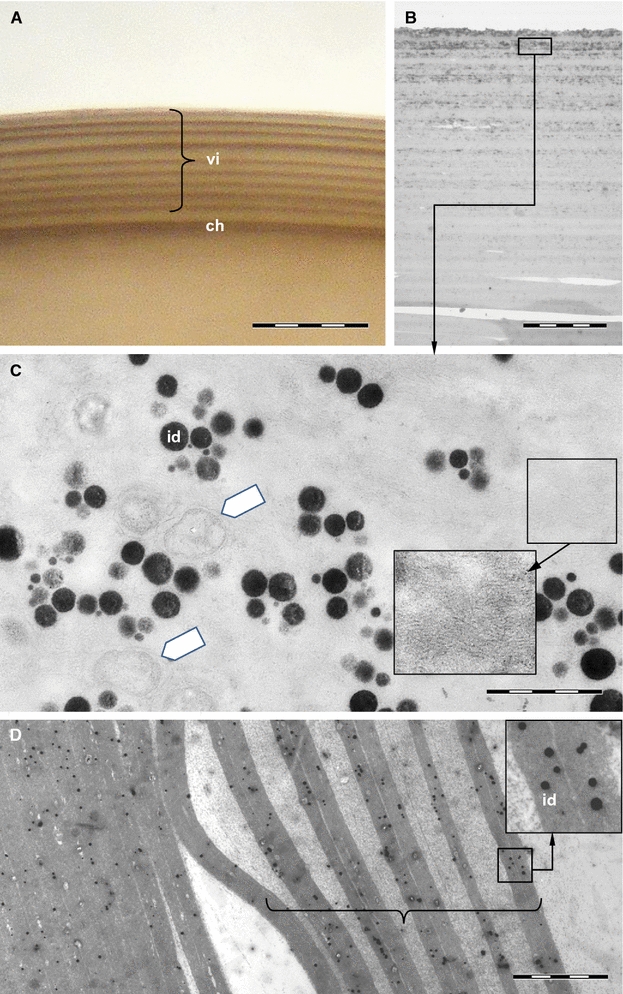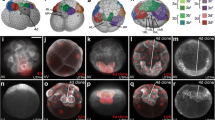Summary
The halibut hatching gland (HG) cells are first observed as a cellular disc in front of the embryonic head around the midpoint of intra ovo development. The disc is subsequently transformed into a loop of increasing diameter as the HG cells migrate over the anterior part of the yolk sac. When the HG disc is transformed into a loop, the density of HG cells is highest at the migratory front. Some HG cells lag behind the migrating front at the early stages of HG development. At maturity, all cells are contained in a narrow belt which is about 10 cells wide. The HG belt structure consists of a monolayer of HG cells, and is maintained while the cells migrate between the two epidermal cell layers. Migration is halted about 2 days before normal hatching when the HG cells reach a destination at about a right angle to on the embryonic axis. Under the scanning electron microscope, the differentiating HG cells protrude as a ridge the yolk sac surface. The HG cells immunostain with antiserum to hatching enzyme when the HG is observed as a crescent structure around the embryonic head. By counting the number of immunostaining cells in composite photos of the entire yolk sac membrane, we found that the HG belt consists of approximately 2000 secretory cells at maturity. This cell number stays fairly constant throughout the period of HG cell migration. Accordingly, mitoses of the halibut HG cells have generally ceased prior to morphogenesis, and cytodifferentiation is already quite advanced when cell migration starts.
Similar content being viewed by others
References
Bouvet J (1976) Enveloping layer and periderm of the trout embryo (Salmo trutta fario L.). Cell Tissue Res 170:367–382
Ciment G (1990) The melanocyte Schwann cell progenitor: A bipotent intermediate in the neural crest lineage. Comments Dev Neurobiol 1:207–223
Hagenmaier HE (1973) The hatching process in fish embryos: the structure, polysaccharide and protein cytochemistry of the chorion of the trout egg, Salmo gairdneri. Acta Histochem 47:61–69
Helvik JV (1988) Hatching mechanism in halibut (in Norwegian). Cand Scient Thesis, Univ of Bergen
Helvik JV, Pittmann K (1990) Light affects hatching, development and pigmentation of halibut (Hippoglossus hippoglossus). Int Council for the Exploration of the Sea Council Meeting F: 40
Helvik JV, Oppen-Berntsen DO, Walther BT (1991) The hatching mechanism in Atlantic halibut (Hippoglossus hippoglossus). Int J Dev Biol 35:9–16
Hollande AC (1918) Enrichissement de liquid fixateur de Bonin en acide picrique, par addition d'acetate neutre de cuivre. Compt Rend Soc Biol 81:17
Ishida I (1985) Hatching enzyme: Past, present and future. Zool Sci 2:1–10
LeDouarin NM, Smith J (1988) Development of the peripheral nervous system from the neural crest. Ann Rev Cell Biol 4:375–404
Lønning S, Kjørsvik E, Haug T, Gulliksen B (1982) The early development of the halibut, Hippoglossus hippoglossus (L.), compared with other marine teleosts. Sarsia 67:85–91
Lønning S, Kjørsvik E, Davenport J (1984) The hardening process of the egg chorion of the cod, Gadus morhua L., and lumpsucker, Cyclopterus lumpus L. J Fish Biol 24:505–522
McClay DR, Ettensohn CA (1987) Cell adhesion in morphogenesis. Ann Rev Cell Biol 3:319–345
Oppen-Berntsen DO, Bogsnes A, Walther BT (1990a) The effects of hypoxia, alkalinity and neurochemicals on hatching of Atlantic salmon eggs. Aquaculture 86:417–430
Oppen-Berntsen DO, Helvik JV, Walther BT (1990b) The major structural proteins of cod (Gadus morhua) eggshells and protein crosslinking during teleost egg hardening. Dev Biol 137:258–265
Rosenthal H, Iwai T (1979) Hatching glands in herring embryos. Mar Ecol Progr Ser 1:123–127
Schoots AFM, Opstelten RIG, Denuce JM (1982) Hatching in the pike (Esox lucius) L.: Evidence for a single hatching enzyme and its immunocytochemical localization in specialized hatching gland cells. Dev Biol 89:48–55
Schoots AFM, Sackers RJ, Overkamp PSG, Denucé JM (1983) Hatching in the teleost Oryzias latipes: limited proteolysis causes egg envelope swelling. J Exp Zool 226:93–100
Willemse MTM, Denucé JM (1973) Hatching glands in the teleosts. Brachydanio rerio, Danio malabaricus, Moenkhausia oligolepsis and Barbus schuberti. Dev Growth and Differ 15:169–177
Yamagami K (1988) Mechanism of hatching in fish. Fish Physiol XIA:447–499
Yanai T (1966) Hatching. In: Kume M (ed) Embryology of vertebrates. Baifukan, Tokyo, pp 49–58
Yanai T, Ouji J, Iga T (1956) Development of the hatching glands in the teleost, Hypomesus olidus (Pallas). Annot Zool Jpn 29:28–33
Yokoya S, Ebina Y (1976) Hatching glands in salmonid fishes, Salmo gairdneri, Salmo trutta, Salvelinus fontinalis and Salvelinus pluvius. Cell Tissue Res 172:529–540
Author information
Authors and Affiliations
Additional information
Offprint requests to: J.V. Helvik
Rights and permissions
About this article
Cite this article
Helvik, J.V., Oppen-Berntsen, D.O., Flood, P.R. et al. Morphogenesis of the hatching gland of Atlantic halibut (Hippoglossus hippoglossus). Roux's Arch Dev Biol 200, 180–187 (1991). https://doi.org/10.1007/BF00361335
Received:
Accepted:
Issue Date:
DOI: https://doi.org/10.1007/BF00361335




